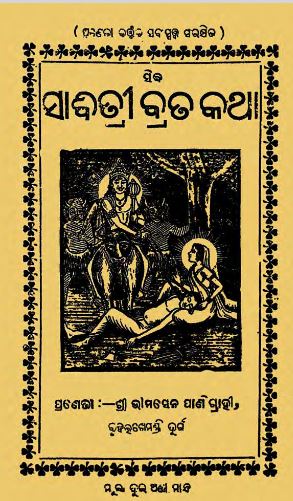Sabitri Brata Katha, authored by Bhimasen Panigrahi and published in 1952, is a cherished Odia story that intricately weaves together themes of love, devotion, and the power of faith. Set against the backdrop of traditional Odia culture, the narrative explores the poignant tale of Sabitri, a devoted wife whose unwavering love for her husband culminates in a powerful act of devotion that transcends mortal bounds.
At the heart of the story lies the legendary observance of the Sabitri Brata, a significant religious occasion celebrated by married women in Odisha. It is observed with the belief that honoring the story of Sabitri—who fought against the forces of death to save her husband Satyaban—can bestow blessings for the long life and prosperity of their spouses. Bhimasen Panigrahi captures the essence of this revered ritual through Sabitri’s tale, illustrating how love can inspire acts of bravery and determination.
The narrative begins by immersing the reader in the idyllic setting of rural Odisha, where traditions run deep, and communal values are upheld. Sabitri, an epitome of virtue and fidelity, embodies the ideal qualities of a devoted wife, characterized by her unwavering commitment and selflessness. The author presents her devotion not merely as a duty but as a profound expression of love that drives her to undertake the challenges posed by fate.
When Sabitri learns of her husband Satyaban’s impending death, the story takes a dramatic turn. Undeterred by this grim prophecy, Sabitri’s love manifests in her determination to confront Yama, the god of death, and plead for her husband’s life. Bhimasen Panigrahi beautifully depicts her encounter with Yama, where her eloquent arguments, woven with emotion and devotion, challenge the concepts of fate and destiny. This confrontation not only showcases her bravery but also highlights the strength of love as a catalyst for change.
Throughout the narrative, the author skillfully integrates the elements of Odia folklore and spirituality, enriching the tale with cultural nuances. The dialogues are imbued with traditional wisdom, and the imagery is vivid, allowing readers to visualize the ritualistic elements of the Sabitri Brata observance. Bhimasen Panigrahi’s prose is both lyrical and poignant, inviting readers to reflect on their own relationships and the sacrifices made in the name of love.
“Sabitri Brata Katha” also serves as a commentary on the role of women in society, emphasizing their strength and resilience. Sabitri is portrayed not merely as a passive character, but as a proactive force in her own narrative. The story uplifts the role of women in their households and highlights the importance of their emotional contributions, thus reinforcing a sense of reverence for the feminine spirit.
In conclusion, Sabitri Brata Katha by Bhimasen Panigrahi is a timeless tale that beautifully encapsulates the essence of love and devotion within the framework of Odia culture. It serves as a reminder of the power of faith and commitment, encouraging readers to reflect on the nature of love and the lengths to which one will go to protect those they cherish. This story remains relevant today, continuing to inspire generations with its profound messages of love, courage, and the enduring bonds of matrimony.
Books Info
| Books name | Sabitri Brata Katha |
| Author | Bhimasen Panigrahi |
| No Of pages | 16 |
| Publisher | NA |
| Publication | 1952 |
| Printed At | NA |
| Distributor | NA |

